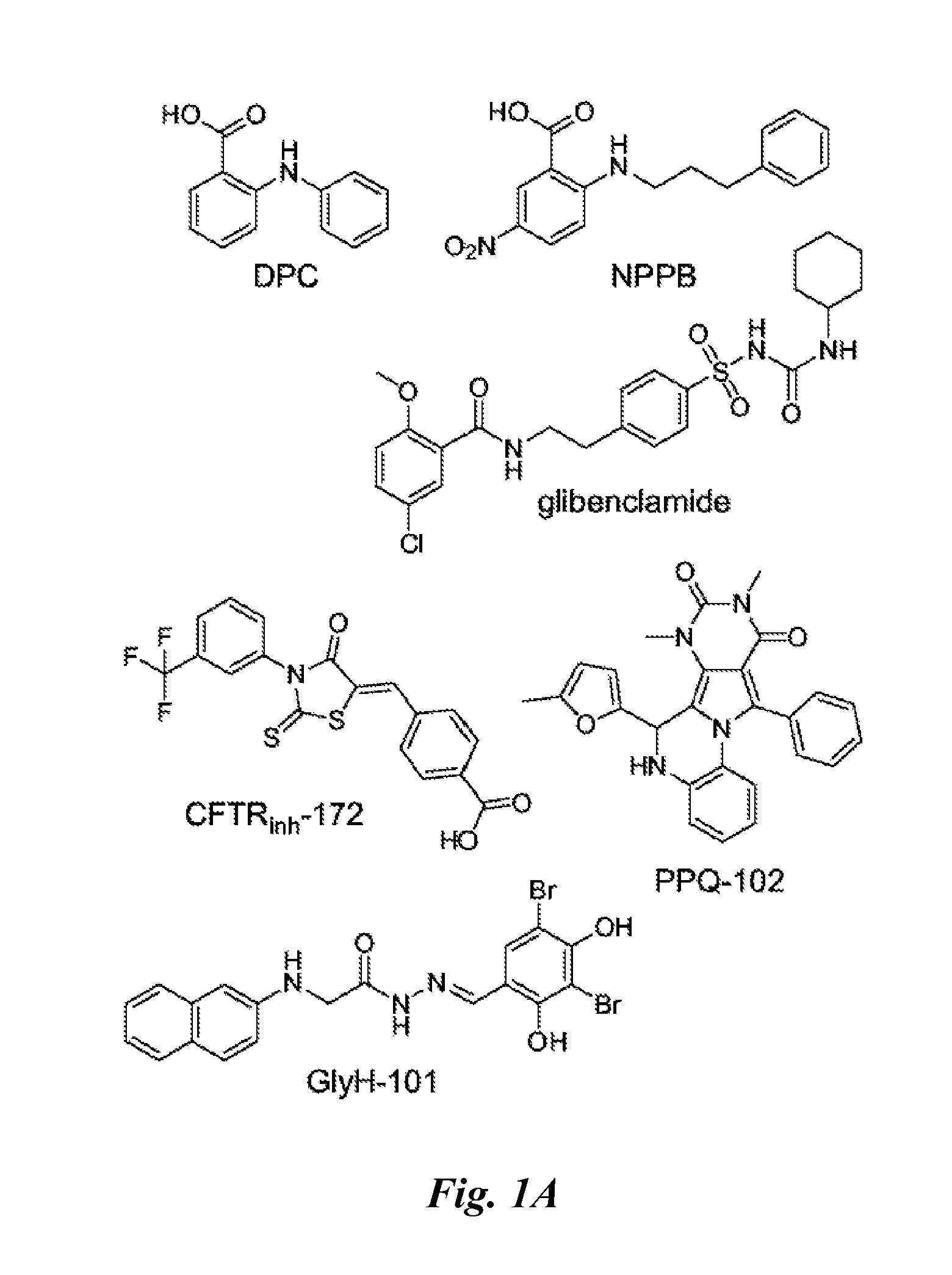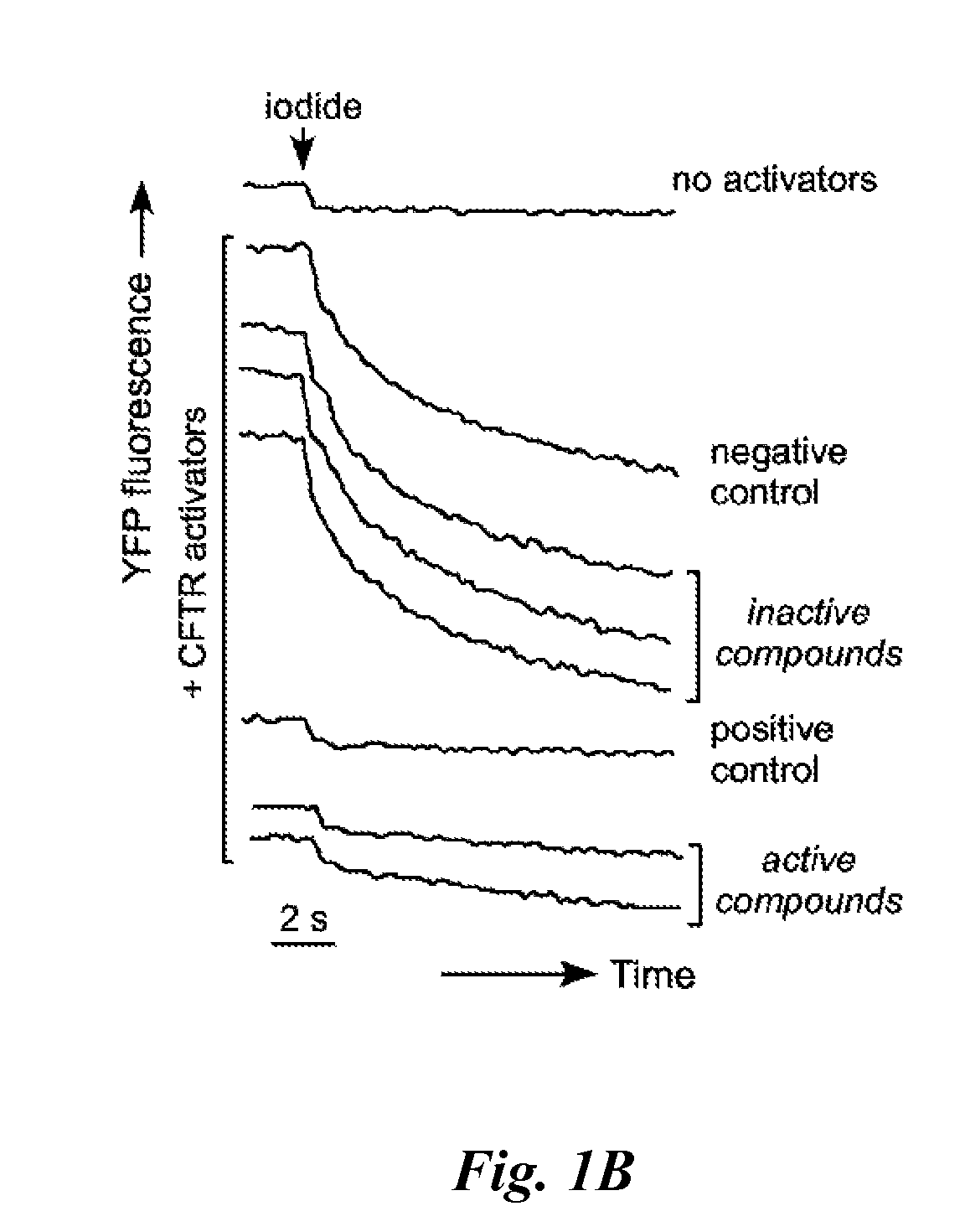Pyrimido-pyrrolo-quinoxalinedione inhibitors of cystic fibrosis transmembrane conductance regulator protein and uses therefor
a technology of transmembrane conductance regulator and pyrroloquinoxalinedione, which is applied in the direction of biocide, animal repellents, drug compositions, etc., can solve the problems of lack of cftr specificity, weak potency of many antibiotics, and ineffective treatment of many pathogens, so as to inhibit the enlargement of kidney cysts, inhibit the formation of cysts, and increase the activity of cftr chloride channel
- Summary
- Abstract
- Description
- Claims
- Application Information
AI Technical Summary
Benefits of technology
Problems solved by technology
Method used
Image
Examples
example 1
Synthesis of PPQ-102
[0157]Synthesis procedures (General)—1H and 13C NMR spectra were obtained in deuterated dimethyl sulfoxide (DMSO-d6) using a 400-MHz Varian Spectrometer referenced to DMSO. Mass spectrometry was performed using a Waters LC / MS system (Alliance HT 2790+ZQ, HPLC: Waters model 2690, Milford, Mass.). Flash chromatography was performed using EM silica gel (230-400 mesh), and thin-layer chromatography was performed using Merk silica gel 60 F254 plates (Darmstadt, Germany). Microwave reactions were performed in a Biotage Initiator™ (Biotage, Uppsala, Sweden) (0.5-2 mL vials) with target temperature reached within 30 s at ˜55 watts. Melting points are uncorrected. Purity to >98% was confirmed by LCMS.
[0158]Synthesis of PPQ-102—Synthesis of PPQ-102 was achieved in six steps as illustrated in FIG. 2B. Commercially available 6-methyluracil 1 was methylated using dimethylsulfate to produce 1,3,6-trimethyluracil 2, which upon Friedel-Crafts acylation using zinc chloride as a c...
example 2
Biological Methods
[0167]A. Cell lines and compounds—Fischer rat thyroid (FRT) cells co-expressing human wildtype CFTR and the halide indicator YFP-H148Q / 1152L were generated as described (see, e.g., Ma et al., J. Clin. Invest. 110:1651-1658 (2002)). Cells were plated in 96-well black-walled microplates (Corning Costar) at a density of 20,000 cells per well in Coon's modified F12 medium supplemented with 5% fetal calf serum, 2 mM L-glutamine, 100 U / mL penicillin, and 100 μg / ml streptomycin. Assays were performed at 48 h after plating the cells when the cells were just confluent. For some experiments, measurements were made using T84 human intestinal epithelial cells and for other experiments, measurements were obtained using primary cultures of human bronchial epithelial cells, which were obtained and grown essentially as previously described (see, e.g., 3 and 27).
[0168]The compound collections used for screening to identify CFTR inhibitors included approximately 105,000 synthetic sm...
example 3
Identification of PPQ Compounds as CFTR Inhibitors
[0173]Collections of synthetic and natural compounds were screened according to the screening procedures described in Example 2. A cell-based fluorescence assay was used in which CFTR inhibitors were identified by reduced iodide influx in FRT cells co-expressing human CFTR and a YFP halide sensor. CFTR was maximally activated by a mixture of agonists having different activating mechanisms. Inhibition of iodide influx was observed as reduced YFP fluorescence quenching in response to rapid iodide addition to each well of 96-well plates. Based on prior knowledge that a small percent of active CFTR inhibitors are identified from random screening of compounds, primary screening was performed at 25 μM test compounds that were pre-incubated for 15 min prior to measuring fluorescence.
[0174]FIG. 1B shows exemplary YFP fluorescence data in negative control (vehicle-only) wells, positive control (10 μM CFTRinh-172) wells, and in wells containin...
PUM
| Property | Measurement | Unit |
|---|---|---|
| voltages | aaaaa | aaaaa |
| voltages | aaaaa | aaaaa |
| voltages | aaaaa | aaaaa |
Abstract
Description
Claims
Application Information
 Login to View More
Login to View More - R&D Engineer
- R&D Manager
- IP Professional
- Industry Leading Data Capabilities
- Powerful AI technology
- Patent DNA Extraction
Browse by: Latest US Patents, China's latest patents, Technical Efficacy Thesaurus, Application Domain, Technology Topic, Popular Technical Reports.
© 2024 PatSnap. All rights reserved.Legal|Privacy policy|Modern Slavery Act Transparency Statement|Sitemap|About US| Contact US: help@patsnap.com










